Hello! About a year ago, red scabs appeared on the neck of the cat under the fur, which she brushed very hard, but they periodically passed, then reappeared. A couple of months ago, the same ones appeared on their hind legs with inside, the cat scratches and licks them all the time. We went to the veterinarian, gave ointment with tar, but it did not help. About three weeks ago, we saw blotches of blood in the urine, how long I can't say, because before that, she went outside until it got cold. We went to the veterinarian, he said that she had these scabs due to a malfunction in the liver and kidneys, but urine analysis is not done here, but only a scraping from the skin was taken, they said that it was not shingles and not a tick. They give the cat injections with suprastin, some antibiotics, calcium, there is no improvement. After the injections, the cat runs around the house, saliva runs, behaves very strangely, then begins to move its hind legs poorly. All this time she is eating and drinking normally. What treatment is carried out in such cases, is such a reaction to injections normal? There is no other clinic here, and we are very worried about the cat, but we do not know how to help her.
Hello!
There can be quite a few reasons for the symptoms you describe. Describe in detail the diet of the animal, indicating the ingredients included in it. When did you perform routine deworming? When was the animal vaccinated and with what vaccine? What vitamin preparations do you use additionally? This is very important diagnostic information. Submit it shortly.
Please note that feeding with Whiskas, Friskas, Meow, Felix and Kitiket is not recommended for feeding cats. Neither dry nor wet. These are very harmful feeds that can sooner or later provoke gastrointestinal diseases and quite often lead to the death of the animal. Sausages, milk, soups, borscht and everything else "what we ourselves eat" is not applicable to the nutrition of cats. This rule is. Feed your animal either quality commercial food: Acana, Gina, Orijen, Hills, Royal Canin, Eukanuba, Go Natural, or Now Fresh. Or natural products: rice, oatmeal, buckwheat + beef, turkey, rabbit (but not in the form of minced meat) and stewed vegetables (cabbage, cauliflower, carrots, beets). The percentage of meat in the main diet is at least 70%. Also remember that you should never mix natural food and industrial feed. Vitamins must be used for any type of food, for 1-1.5 months. 2 p. in year.
The animal has allergies and miliary dermatitis. Perhaps hypovitaminosis also has a significant effect on the manifestation of this kind of symptomatology. Treatment should be comprehensive.
- Instead of water - a decoction of chamomile 1 tsp. Boxes. for 1 liter of water - up to 7-10 days.
- White coal 1 tablet or Ataxil 10-20 ml. ext. 2 p. in the village - up to 12 days in 60 minutes before or after eating and giving drugs vn.
- Nux Vomica 5 cap. for 1 tsp. water int. 3 p. in the village - up to 7-10 days.
- Mezim 1 tab. ext. 2 p. in the village - up to 10 days.
- Emprobio 4 ml int. 2 p. in the village in 30 minutes. before meals - up to 14 days. or Hilak 5-6 cap. 10 ml of water int. 2 p. in the village - up to 7-10 days.
- Salvikal or Vitabon up to 3 months according to the instructions
- Bathe the animal with TropiClean Oxy-Med Oatmeal Shampoo, removing all the crusts, then once every 1-2 months.
- Treat the affected areas with hydrogen peroxide 2-3 r. in d. to complete cleanliness up to 14 days.
- Local treatment with Chlorhexidine 3 r. in the village up to 14 days
- Lubricate the affected areas with methylene blue (alcohol solution) 2 r. in d. up to 12 days
- 20 minutes after item No. 10, lubricate the affected areas with Clotrimazole or Ekodax 2 r. in d. up to 12 days
- Wear a plastic veterinary collar that prevents self-injury up to 14 days.
- Suprastin 0.5 ml i.m. 2 p. in d. up to 12 days
- Lipoton 0.5 ml pc. 2 p. in d. up to 12 days
Inform about the condition of the animal once every 3-5 days.
The appearance of sores on the neck in a cat is associated with the presence of a primary infection. The animal itches, shows nervousness,. When starting treatment, you must first find out the reasons.
Why does a cat have sores on its neck and itch?
Sores on the neck can cause a lot of trouble for a cat.
The most common of these is the subcutaneous scabies mite. Depending on the type of mite, the disease is called notoedrosis or sarcoptic mange. And in fact, and in another case, the treatment is the same.
Allergy in cats
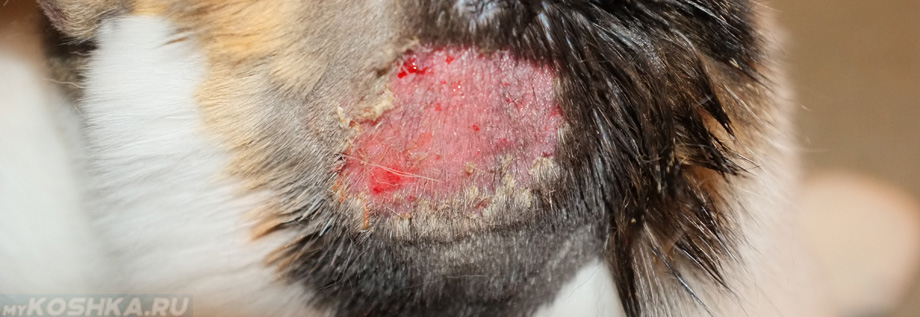
This sore was small, then the cat scratched it because of severe itching.
Allergy can also serve as a causative agent - food or dust... Sores are first localized on the neck, then go to the chin and forehead. They look like dried crusts, then, when the animal begins to lick them, they get wet and become wounds. does not seem possible. To identify an allergen, you should go to the clinic for laboratory tests.
Fleas
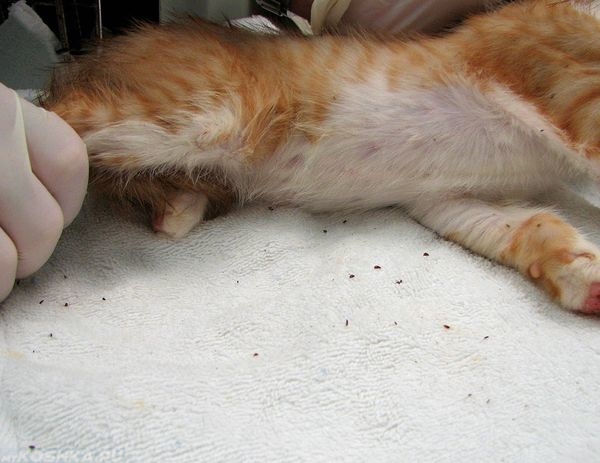
Another important factor is. Insect bites are brushed to blood by the cat, which leads to wounds, which, in turn, become inflamed, providing favorable environment for the reproduction of pathogens.
Bacterial dermatitis
Bacterial dermatitis is another cause of neck wounds.

Neck wound due to irritation from bacterial dermatitis. Cat from a for severe itching he constantly scratches the wound. A big sore formed.
The advanced stage of the disease leads to more severe consequences: fistulas, nodes,. Bacterial dermatitis is often a secondary pathology caused by diseases such as endocrine disorders of the body, allergies.
How to treat sore neck at home
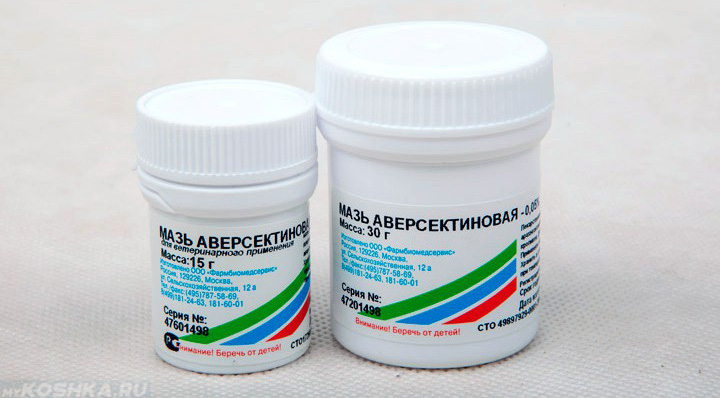
If a subcutaneous tick is found in a cat, the following measures are taken:
- isolate the animal;
- cut off the affected area of \u200b\u200bwool;
- wash with keratolytic shampoo;
- apply aversectin ointment;
- prescribe the drug "Advocate" in the form of drops;
- use sulfuric ointment;
- dripping drops of "Amit Forte";
Starting treatment, you should thoroughly disinfect all pet toys, habitats, bedding, dishes.
Allergy
Allergy can be to saliva fleas, food, atopic dermatitis ... An allergic reaction to flea saliva can be easily treated with topical insecticidal treatments. Drops, sprays, collars, powder are recommended.
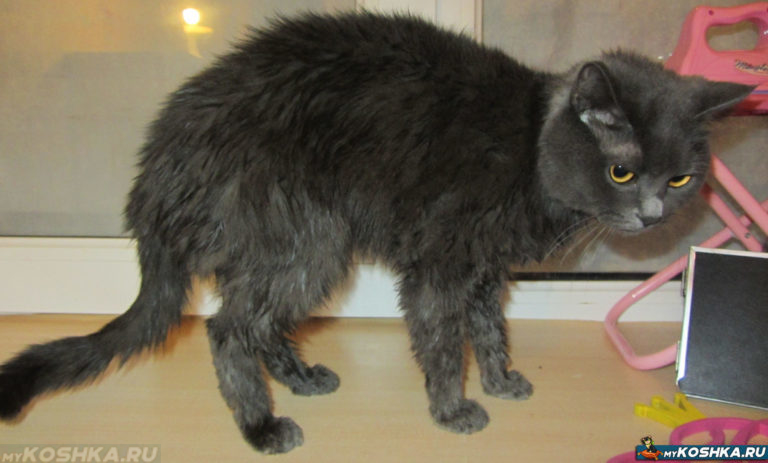
Bathing with medicated shampoos is indicated to treat sources of itching.
Eliminated by excluding dangerous products from the diet. The use of symptomatic therapy, cleansing agents for the body is recommended. Shown, the appointment of steroid, antihistamines. Antibiotics are prescribed to treat scratching, preventing the risk of contracting other infections.
There is no one hundred percent cure for atopic dermatitis.
Pathology of a genetic nature and the periodic manifestation of relapses and new outbreaks of the disease are almost guaranteed. It often runs latently and is imperceptible until complications appear. Supportive therapy, control of the occurrence of secondary infections based on atopic dermatitis is recommended. A cat with this type of allergy will have to maintain its body throughout its life.
Flea control
There are various topical preparations available to combat fleas.
Can be used powders for kittens , but use with extreme caution, as they are often toxic and irritating to respiratory system... For adults over six months old, collars are used. The collar lasts up to three months. The most effective remedy - drops on the withers.
Most often used frontline - eliminate fleas within 24 hours, prevent the appearance of insects for two months. Hartz drops have good recommendations. Affects flea eggs and larvae. Before use, the animal must be bathed with a flea shampoo.
Suitable for cats in contact with other animals. Drops advocate are useful not only against fleas. The destructive effect is produced on ticks, worms are removed. Stronghold and leopard drops are also recommended. Frontline spray will have a positive effect.
Dermatitis
There is no single correct treatment regimen for bacterial dermatitis.
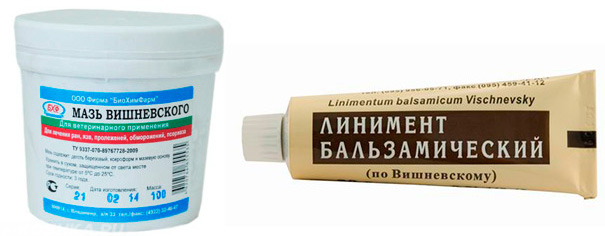
Treating bacterial dermatitis is difficult. But preparations based on Vishnevsky Ointment have proven themselves well.
Help will be based on the primary cause. In the case of a traumatic form, the affected areas are treated with a solution of iodine, methylene blue. Prescribe lotions with astringents, a compress using vishnevsky ointment .
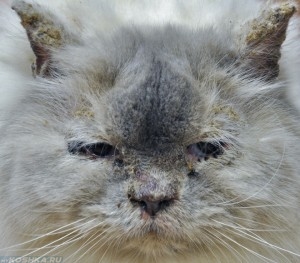
Purulent dermatitis causes crusty sores.
Treatment of purulent dermatitis includes cutting the hair of the sore spot, removing dried crusts, and treating with antiseptics. Sprinkle with streptocide powder, antibiotic. For a more severe or advanced form, antibiotic injections or oral administration are prescribed.
Take over several weeks. The medicine is indicated for use in tablets Ivermectin, Milbemycin. The course of admission is calculated for three months. It is recommended to bathe your pet in a solution from ticks, regular washing with medicated antibacterial shampoos.
Preventive actions
Talking about prevention skin diseases, you should pay special attention to vaccination.
The animal must be vaccinated without fail, then the risk of infection will decrease, and immunity will increase. Vaccinations must be done strictly according to the schedule established by the doctor. Mandatory preventive examination, full comprehensive examination.
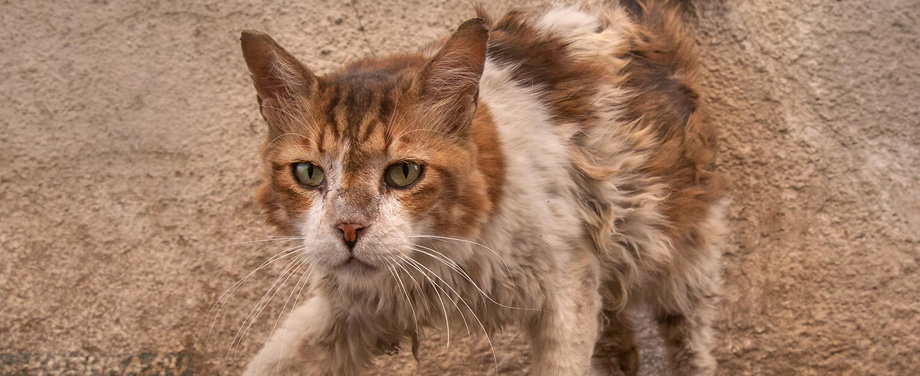
Avoid contact with street cats.
The cat's habitat should be disinfected periodically. Treat against ticks, worm infestations, fleas and other insects. The pet's dishes must be kept perfectly clean, the tray must be cleaned and disinfected on time.
Avoid contact of the cat with other animals, possible vectors of diseases. Meat and fish products should not be given raw to avoid the risk of infection with helminths. Strictly control the quality of the animal's nutrition, do not introduce into the diet obviously dangerous or suspicious foods to which the cat may develop an allergic reaction.
Avoid "random food" - trash cans, buckets. Observe all standards of sanitation and personal hygiene of your pet.
The skin performs not only protective functions, protecting the muscles and internal organs from injury. It is a barrier to billions of pathogens that can compromise your pet's health. Therefore, any skin disease in cats should be taken seriously: unhealthy skin is the gateway for bacteria, viruses and other pathogens of many diseases.
In addition to the protective function, the skin takes part in the synthesis of various vitamins, provides thermoregulation and removes toxins from the body. Diseases of the skin in cats negatively affect health in general: immunity decreases, the work of internal organs and all systems deteriorates. Therefore, if you notice any changes in the condition of the skin, be it ulcers on the skin of cats or a seemingly harmless rash, you should consult a specialist.
There are dozens of skin diseases and hundreds of forms of their manifestations. Many are symptomatically similar so much that even an experienced doctor does not immediately correctly diagnose the disease. If you notice sores on the cat's skin, you cannot rely on self-medication. You should not even try to treat your pet with complex ointments - this will only complicate the diagnosis. In addition, treatment by any means makes laboratory tests ineffective - you have to wait a week before the doctor can take material for research. Have sores or wounds on the cat's skin? We immediately go to the doctor, without treating the affected areas.
Common cat skin diseases
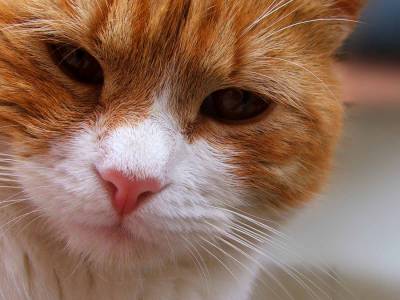
FUNGAL AND - the skin is inflamed, reddening and changes in structure (tubercles, furrows) are clearly noticeable. The cat, in many (but not all) cases, develops severe itching, which usually intensifies in the evening. Sometimes the pet scratches the skin until it bleeds, rolls on the floor and gnaws at the affected areas, as if trying to catch a flea. The hair falls out locally, the bald patches are clearly defined. In the center of bald patches, the skin is most inflamed; at the edges it can look practically healthy. Treatment: immunity support and a well-chosen remedy that kills the identified bacteria or fungus.
FLEA DERMATITIS is an allergic reaction to waste products and flea bites. In a cat, sores form on the skin within a few minutes after the bite - an itchy red seal. Hypersensitive cats develop a rash from crown to tail, scratch their skin until they bleed, become nervous, lose their appetite. Treatment: Execan in half a cube once a day / five days, flea drops.
ALLERGIC DERMATOSIS - a reaction to an allergen contained in food. In most cases, the cat scratches itself for a long time, but looks healthy. When the allergen accumulates in sufficient quantity for an obvious reaction, an itchy rash appears on the skin. In case of acute reactions, the rash appears immediately, swelling of the paws, lips, eyelids, larynx may appear - in this case, you must immediately show the cat to the doctor. Treatment: the same Execan or equivalent plus diet. It is imperative to donate blood for an allergy test in order to know exactly which foods should be excluded from the cat's diet.
SEBOREA develops as a result of overactive sebaceous glands. The coat looks dirty the very next day after bathing, the base of the hairs sticks together. A cat has crusts on the skin - exfoliated scales plus sebum. Sometimes the discharge will form foul-smelling bumps and lumps. Complex treatment: cleansing the skin, changing the diet, gently degreasing the coat and skin. Excessive sebum production can be caused by hormonal imbalance or chronic illness, therefore, the pet must be examined completely.
OSTEOPHOLLICULITIS is a purulent inflammation of the sebaceous ducts and glands. Many skin diseases in cats, from staphylococcus to seborrhea, can provoke this ailment: the sebaceous gland becomes clogged, pus accumulates inside, an abscess forms on the skin, which eventually bursts and dries up. Treatment depends entirely on the cause, as determined by the veterinarian. Do not squeeze out pustules! If necessary, this will be done by a veterinarian under sterile conditions.
FOLLICULITIS - small pustules in the surface layers of the skin. There are many reasons for the occurrence, but most often it is or, penetrating into the smallest wounds on the skin of a cat (scratches, scratches, insect bites). Without treatment, it can turn into furunculosis - very painful purulent formations the size of a large pea. With folliculitis and furunculosis in a cat, yellow skin in the affected areas - pus accumulated under the skin is visible. Comprehensive treatment: diet change, immunostimulants, antibiotics, local treatment.
CARBUNCULOSIS - purulent inflammation of the sebaceous glands and hair follicles located nearby. At the initial stage, a small lump is formed, filled with pus. The pimple grows, tissue necrosis develops inside it. There may be several outlets - greenish-yellow pus flows out of them. Over time, the holes merge into one, forming a weeping painful ulcer. If left untreated, multiple skin ulcers in cats can kill your pet! Complex treatment: local treatment, antibiotics, supportive therapy.
Skin infection of a bacterial nature (Proteus, Pseudomonas aeruginosa, staphylococci, etc.). Initially, the cat scratches, then hard reddish lumps appear on the skin. Over time, papules increase and form, which open and dry out. Scabs on the skin of cats coexist with hard papules, brewing and opening pustules, a heavy unpleasant odor emanates from the pet. Complex treatment: antibiotics, immunity support, diet therapy, local treatment.
ECZEMA - chronic inflammatory processwhich develops for many reasons: allergies, stress, infections, diseases of internal organs, etc. It is often seasonal in nature with exacerbations in spring / autumn. Dry and wet eczema are skin diseases in cats, in which it is necessary to carefully examine the pet. Symptoms range from itching and a pinkish rash to severe scratching, hair loss, or flaky skin.
SKIN CANCER - mutational changes in epidermal cells. Oncological diseases of the skin in cats can "disguise" as dermatitis or furunculosis, look like small "harmless" bumps or age spots. Diagnosis is based on biopsy results.
Whatever the symptoms, a visit to the vet is a must. A change in the state of the skin is often a sign of a disease of internal organs, chronic infection, malfunction of one of the body systems, etc. For example, if a cat's skin turns yellow, and / or the gallbladder is suspected, a bluish tint of depigmented skin indicates possible disorders in the work of the cardiovascular systems.
Animal lovers take the disease of their pets very hard. Especially when they do not know what they are faced with and how to treat it. So in the case when incomprehensible sores on cats appear on the neck and the animal suffers, suffers, and the owner simply does not know how to help him.
Undoubtedly, before treating any disease, you should figure out what it can be. Most often, a sore on a cat's neck appears in case of infection with a subcutaneous itch mite (notoedrosis or sarcoptic mange). In this case, the treatment is the same. The animal is treated with stronghold or amitan. If the treatment is carried out with Amitan, then it should be diluted with water (one ampoule per half a liter of water) and after that the procedure should be carried out. The cat should first be washed, and then rinsed with the prepared solution. The solution on the animal's fur is kept for five to seven minutes, massaging from time to time.
In addition to treating sore spots, the solution, using a cotton swab, is applied to the surface of the ears and eyebrows, since sores can appear there, they just are not noticeable yet. After maintaining the allotted time, the solution is washed off. This should be done very carefully so that the animal does not get poisoned when it licks the fur. Such treatment should be carried out at least four times with an interval of a week, even if the sores on the cat's neck are no longer visible, so that there is no relapse. It should be recalled that if you do not receive treatment this disease, then the sores can subsequently spread throughout the body of the animal.
If the cause of the sores is a subcutaneous tick, then, in addition to treating the animal, they must disinfect the room. This should be done with a solution of neostomosan, which is usually used to combat hair follicles and scabies mites.
In addition, you can cure sores on a cat's neck with ordinary dust. This method will be much cheaper and no less effective. However, it is more labor intensive, since the dust has a specific smell that cats do not like very much. In addition, the cat's hair will smell unpleasant even after processing. During treatment, the cat should wear a special protective collar so that it does not scratch or lick sores. Also, from time to time, they can be lubricated with dioxidine, although if the treatment is carried out correctly, then this is not necessary. It should be recalled that if there are other animals in the house, then they should also be treated with amitan solution.
You can use the same concentration as for treating a cat. In the annotation to amitan, the concentration of the solution is slightly different (one ampoule per glass of water and do not rinse), however, in order to exclude the appearance of allergies, it is still better to use a weaker solution. In addition, this (low) concentration applies even to guinea pigs, which are known to be very sensitive to toxic substances. Therefore, this medication will certainly not harm the cat. If processing is carried out by stronghold or frontline, then the instructions should be strictly followed. Only in this case will the treatment bring the desired result. Do not forget that one procedure will not be enough. A second one will definitely need to be carried out in seven to ten days.
Sometimes, common fleas can cause sores on the neck of cats. At the same time, cats simply comb the skin, hence the wounds appear. Therefore, before starting treatment for other, more serious diseases, the animal should be checked for fleas.
In addition to a subcutaneous mite, common food or dust allergies can cause sores. In this case, sores appear first on the neck, then on the beard or forehead. At first, they look like dry crusts and, only after the cat licks them, they become weeping. Identifying allergies can be very difficult because they are always individual. In some cats, it can be on a house dust mite, in others on food or flea saliva. In this case, the manifestations of allergies will be the same. In order to decide, you should carry out a special diagnosis in a veterinary clinic.
You can also treat such sores with stringhold drops. Moreover, they are applied to the withers of the cat. Processing should be carried out two to three times at intervals of two weeks. In addition, bacterial dermatitis can be the cause of neck sores. When neglected, it can lead to more severe injuries, such as fistulas, nodules, or abscesses. Most often, this disease is secondary. The primary ones can be demodicosis, endocrine diseases, allergies. Therefore, it is very important to identify what caused the appearance of dermatitis. Since treatment must begin with the elimination of primary diseases.
Despite the fact that for some diseases exactly the same drugs are used, the animal should definitely be shown to a good veterinarian to make sure that the chosen treatment and the diagnosis are correct.
Sores on a cat's neck always indicate that the animal has some kind of disease. Of course, this does not apply to sores after injuries or wounds (when, for example, your cat has been bitten by other cats). If you notice unhealthy rashes, redness, bumps, bald patches, sores, bleeding inflammations in your cat, you should not try to look for the cause on the Internet and self-medicate, you need to take the animal to the clinic so that the veterinarian examines the animal and prescribes the appropriate treatment for the disease.
Sores on a cat's neck usually result from a subcutaneous itch mite in the animal. Weak immunity can contribute to the introduction of such a disease, contacts with animals suffering from a subcutaneous tick, small kittens with mother's milk can pick up a tick.
Also, the cause of the appearance of sores on the cat's neck can be an animal's allergy. It can be both food allergies and allergies to chemical external irritants (powders, cat litter, dust, cigarette smoke, etc.).
Other reasons include simple fleas. Yes, they can also be the culprit for a cat's neck sores. The fact is that with the vigorous activity of fleas, the cat constantly itches. That is why frequent scratching with claws of the cervical zone can lead to micro-wounds, and then large wounds and, as a result, sores.

How to treat sores on a cat's neck
Before starting to treat sores in a cat on the neck, it is necessary to correctly establish the diagnosis. This can only be done by a professional doctor. Therefore, we remind you once again how important it is not to delay the problem, and as soon as you notice the appearance of sores on the cat's neck, you must immediately take her to the veterinary clinic.
Name of veterinary services

Sores on the neck and head
Sores on the neck and head of your cat are most often the result of typical skin conditions such as demodicosis, dermatitis, eczema, allergies, scabies, ringworm, and skin cancer.
If you want to help your pet, please contact our clinic Bio-Vet, here professional doctors will use analyzes and tests to determine the type of disease of your pet and provide the necessary assistance in treating the animal.
